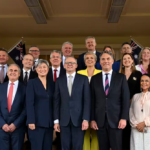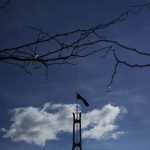Australia’s response to the HIV/AIDS crisis
The first cases of HIV/AIDS first occurred in the early 1980. Professor David Penington was Chairman of the National AIDS Task Force at the time and recounts how the recognition and response to the disease unfolded in Australia ahead of a global AIDS conference in Melbourne.
My first introduction to AIDS was when, after 6 ½ very busy years chairing the Red Cross National Blood Transfusion Committee, I announced to a meeting of the State executives in March 1983 that I would step down as Chair in 6 months. At that meeting I was shown a publication in the New England Medical Journal about the occurrence of AIDS in blood transfusion recipients and in haemophiliacs.
AIDS had been diagnosed in a gay man visiting Sydney from the US, but not in an Australian. It was agreed I would seek information from the US about the disease. Unfortunately the NSW transfusion Director subsequently took it upon him, without any consultation, to put up a notice banning gay men from donating blood, which caused great dismay in their community and picketing of the Sydney BTS.
At that time, homosexuality was illegal in NSW and gays felt, understandably, very threatened. Within two months the first Australian cases of AIDS were identified and on 5 May The Australian ran an article claiming the world faced a new ‘black death’ of unknown cause. There was huge fear in the community as well as a high risk of violence against gay men.
I reported in July to the NH&MRC, on the Council of which I served, that the disease was a potential major pubic health risk. I was asked to form a committee to advise NH&MRC, Government and the public, the latter a very unusual step, but important to curb fears and ill-informed actions. I got an able medical group together from several States, including Ian Gust, an outstanding virologist with WHO connections from work on hepatitis. A further group suffering AIDS in the US was the IV drug injectors and it had all the hallmarks of a blood born virus, despite many alternatives being canvassed in the media.
We established close liaison with the Centers for Disease Control in the US and closely monitored development of research. Of course it was necessary to recommend that sexually active gay men desist from donating blood for transfusion which caused cries from some quarters of discrimination, but once the first case of Australian AIDS due to transfusion was identified in Sydney in mid-1984 this need was imperative.
The virus was identified late in 1883 and we spent a huge amount of time speaking with the media day after day explaining this was a virus disease, not a ‘gay plague’. Soon we could advise that the virus was immediately killed by ‘White King’ outside the body and in any event there was clear epidemiological evidence that it could not be spread by normal social contact. The prejudicial statements about risks of being associated with gay men had no place in public comment.
Ian Gust was able to develop a test for antibody to the virus by September 1994 and found that donations in Victoria used to treat haemophilia contained the virus despite our exclusion of gay men from donating. Then in November four Brisbane babies were found to have been infected from one donation. All four died.
Two weeks before the 1994 Federal election, Neil Blewett convened a Summit meeting of all State Health Ministers. Out of that we were renamed the National AIDS Task Force, with addition of a very able gay psychologist. Ian was given funds to set up a national network testing for the virus. We subsequently supported introduction of legislated penalties for gay men or IV drug users donating blood.
We were given further funding for research and developed testing for every single blood donation and, in strict confidence, for people in the community. We spent months reassuring the public and advising occupation after occupation about any necessary safeguards for prevention of infection and about the absence of risk in a huge number of situations.
Treatment loomed on the horizon with AZT and we recommended the establishment of national data collection and planning of trials for clinical treatment, all to be managed out of UNSW. From the date of the Summit, followed by legislation, further passage of infection through blood transfusion virtually stopped – something not achieved until some years later in virtually every country with significant infection.
Australia did very well, with huge efforts by the gay community on safe-sex and in supporting infected people.
The University of Melbourne will host a free public lecture on 20 July titled ‘Witness Seminar: communication and health policy creation during the Australian AIDS crisis’. The Seminar will bring together academics and contemporary representatives of government and gay and community health activist, to retrace the events unfolding during the height of the crisis. For bookings, please see here.
Professor David Penington AC, DM (Oxon) LLD (Melb.) was a medical undergraduate of the University of Melbourne and graduated in Medicine at Oxford. He was a medical specialist, teacher and researcher in London, then Professor of Medicine at the University of Melbourne (St Vincent’s Hospital) from 1970 to ’87. He was a reforming Dean of the Faculty of Medicine for eight years from 1978, despite involvement in various national committees and Vice-Chancellor of the University for eight years from 1988. Professor Penington founded the North Richmond Community Health Centre and Chaired the National Blood Transfusion Committee for Australian Red Cross. He was Chairman of the NH&MRC Committee on AIDS and the National AIDS Task Force. From 1994 to 2001 he was President of Museum Victoria. He chaired the Victorian Premier’s Drug Advisory Council in 1995-96, a Committee on Drugs for Capital City Lord Mayors in 1997-1999 and the Drug Policy Expert Committee of the Victorian Government in 1999-2000. He became a public advocate of change to policies in dealing with illicit drugs. He was Chairman of the Board of Cochlear Ltd from 1995 to 2002. He has served on the boards of many medical research institutes and chaired the Bio21 Cluster, Neuroscience Victoria and Bionic Vision Australia for some years. The Penington Institute, which seeks to diminish the harm caused by illicit drugs, was named after him in April 2014. His autobiography “Making Waves: Medicine, Public Health, Universities and Beyond” is published by Melbourne University Press July 2010.












